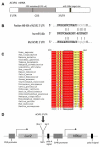ACVR1, a therapeutic target of fibrodysplasia ossificans progressiva, is negatively regulated by miR-148a
- PMID: 22408438
- PMCID: PMC3292007
- DOI: 10.3390/ijms13022063
ACVR1, a therapeutic target of fibrodysplasia ossificans progressiva, is negatively regulated by miR-148a
Abstract
Fibrodysplasia ossificans progressiva (FOP) is a rare congenital disorder of skeletal malformations and progressive extraskeletal ossification. There is still no effective treatment for FOP. All FOP individuals harbor conserved point mutations in ACVR1 gene that are thought to cause ACVR1 constitutive activation and activate BMP signal pathway. The constitutively active ACVR1 is also found to be able to cause endothelial-to-mesenchymal transition (EndMT) in endothelial cells, which may cause the formation of FOP lesions. MicroRNAs (miRNAs) play an essential role in regulating cell differentiation. Here, we verified that miR-148a directly targeted the 3' UTR of ACVR1 mRNA by reporter gene assays and mutational analysis at the miRNA binding sites, and inhibited ACVR1 both at the protein level and mRNA level. Further, we verified that miR-148a could inhibit the mRNA expression of the Inhibitor of DNA binding (Id) gene family thereby suppressing the BMP signaling pathway. This study suggests miR-148a is an important mediator of ACVR1, thus offering a new potential target for the development of therapeutic agents against FOP.
Keywords: ACVR1; BMP; EndMT; FOP; miR-148a.
Figures




Similar articles
-
AAV-Mediated Targeting of the Activin A-ACVR1R206H Signaling in Fibrodysplasia Ossificans Progressiva.Biomolecules. 2023 Sep 8;13(9):1364. doi: 10.3390/biom13091364. Biomolecules. 2023. PMID: 37759764 Free PMC article.
-
BMP signaling and skeletal development in fibrodysplasia ossificans progressiva (FOP).Dev Dyn. 2022 Jan;251(1):164-177. doi: 10.1002/dvdy.387. Epub 2021 Jun 26. Dev Dyn. 2022. PMID: 34133058 Free PMC article. Review.
-
Reduced GS Domain Serine/Threonine Requirements of Fibrodysplasia Ossificans Progressiva Mutant Type I BMP Receptor ACVR1 in the Zebrafish.J Bone Miner Res. 2023 Sep;38(9):1364-1385. doi: 10.1002/jbmr.4869. Epub 2023 Jul 17. J Bone Miner Res. 2023. PMID: 37329499 Free PMC article.
-
Fibrodysplasia ossificans progressiva mutant ACVR1 signals by multiple modalities in the developing zebrafish.Elife. 2020 Sep 8;9:e53761. doi: 10.7554/eLife.53761. Elife. 2020. PMID: 32897189 Free PMC article.
-
The obligatory role of Activin A in the formation of heterotopic bone in Fibrodysplasia Ossificans Progressiva.Bone. 2018 Apr;109:210-217. doi: 10.1016/j.bone.2017.06.011. Epub 2017 Jun 16. Bone. 2018. PMID: 28629737 Free PMC article. Review.
Cited by
-
The role of miRNA and lncRNA in heterotopic ossification pathogenesis.Stem Cell Res Ther. 2022 Dec 15;13(1):523. doi: 10.1186/s13287-022-03213-3. Stem Cell Res Ther. 2022. PMID: 36522666 Free PMC article. Review.
-
MicroRNA-148a is downregulated in gastric cancer, targets MMP7, and indicates tumor invasiveness and poor prognosis.Cancer Sci. 2014 Feb;105(2):236-43. doi: 10.1111/cas.12330. Epub 2014 Jan 6. Cancer Sci. 2014. PMID: 24283384 Free PMC article.
-
The Horizon of a Therapy for Rare Genetic Diseases: A "Druggable" Future for Fibrodysplasia Ossificans Progressiva.Int J Mol Sci. 2018 Mar 26;19(4):989. doi: 10.3390/ijms19040989. Int J Mol Sci. 2018. PMID: 29587443 Free PMC article. Review.
-
Effects of miR-146a on the osteogenesis of adipose-derived mesenchymal stem cells and bone regeneration.Sci Rep. 2017 Feb 16;7:42840. doi: 10.1038/srep42840. Sci Rep. 2017. PMID: 28205638 Free PMC article.
-
Non-coding RNA in endothelial-to-mesenchymal transition.Cardiovasc Res. 2019 Oct 1;115(12):1716-1731. doi: 10.1093/cvr/cvz211. Cardiovasc Res. 2019. PMID: 31504268 Free PMC article. Review.
References
-
- Shore E.M., Xu M., Feldman G.J., Fenstermacher D.A., Cho T.J., Choi I.H., Connor J.M., Delai P., Glaser D.L., LeMerrer M., et al. A recurrent mutation in the BMP type I receptor ACVR1 causes inherited and sporadic fibrodysplasia ossificans progressiva. Nature Genet. 2006;38:525–527. - PubMed
-
- Kaplan F.S., Xu M., Seemann P., Connor J.M., Glaser D.L., Carroll L., Delai P., Fastnacht-Urban E., Forman S.J., Gillessen-Kaesbach G., et al. Classic and atypical fibrodysplasia ossificans progressiva (FOP) phenotypes are caused by mutations in the bone morphogenetic protein (BMP) type I receptor ACVR1. Hum. Mutat. 2009;30:379–390. - PMC - PubMed
Publication types
MeSH terms
Substances
LinkOut - more resources
Full Text Sources

